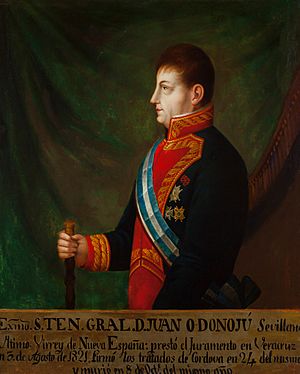Juan O'Donojú facts for kids
Quick facts for kids
The Most Excellent
Juan O'Donojú
|
|
|---|---|
 |
|
| Jefe Político Superior, 62nd and The Last Viceroy of New Spain | |
| In office 3 August de 1821 – 27 September 1821 |
|
| Monarch | Ferdinand VII of Spain |
| Preceded by | Juan Ruiz de Apodaca, 1st Count of Vendetta |
| Succeeded by | Agustín de Iturbide (President of the Regency of the Mexican Empire) |
| Regent of the Mexican Empire | |
| In office 28 September 1821 – 8 October 1821 |
|
| Preceded by | Himself (as Jefe Político Superior) |
| Succeeded by | Agustín de Iturbide |
| Prime Minister of Spain | |
| In office 10 October 1813 – 17 October 1813 |
|
| Monarch | Joseph I |
| Preceded by | Mariano Luis de Urquijo |
| Succeeded by | Fernando de Laserna |
| Personal details | |
| Born | 30 July 1762 Seville, Kingdom of Spain |
| Died | 8 October 1821 (aged 59) Mexico City, First Mexican Empire |
| Signature |  |
Juan de O'Donojú y O'Ryan (30 July 1762 – 8 October 1821) was a Spanish military officer. He was the last Viceroy of New Spain, which is now Mexico. He served from July to September 1821, during the Mexican War of Independence.
O'Donojú was chosen as viceroy during the final stages of the war. Spain hoped he could make a deal with the Mexican independence movement. But when he arrived in August 1821, most of New Spain was already free from Spanish control. He officially recognized Mexico's independence through the Treaty of Córdoba. Sadly, he died soon after. The Spanish government did not agree with his decision until 1836.
Contents
Early Life and Family History
Juan O'Donojú was born in Seville, Spain. His family had Irish roots. He was the third of five children from his father's second marriage.
His family, both on his father's and mother's sides, moved to Spain in the 1720s. They left Ireland to escape strict laws against Catholics. These laws were called the Penal Laws against Irish Catholics.
Military Career and Rise to Power
O'Donojú joined the army when he was young. He fought bravely in the Peninsular War against France. He became a Lieutenant General because of his good service.
He was the Chief of Staff for General Gregorio García de la Cuesta. This was during the Battle of Talavera in 1809. O'Donojú even helped as an interpreter between General Cuesta and the British commander, Sir Arthur Wellesley. Wellesley later became the Duke of Wellington.
In 1814, O'Donojú was made Minister of War. This was a very important job. He also became a close aide to King Ferdinand VII of Spain.
O'Donojú was known for his liberal ideas. He was friends with a liberal rebel named Rafael del Riego. In 1820, when Spain brought back its constitution, O'Donojú was a high-ranking general in Andalusia. He was also a high officer in the Spanish Freemasons. In 1821, the Spanish government gave him the authority of a viceroy. They hoped he could help solve the problems in New Spain.
Last Viceroy of New Spain
Why He Was Appointed
Many people believe O'Donojú was chosen as viceroy because Mexican leaders in Spain supported him. They hoped his liberal views would help end the fight for independence. The Spanish government also wanted to give more freedom to its overseas lands.
Arrival in Mexico
Juan O'Donojú arrived in Veracruz, Mexico, on August 3, 1821. He quickly saw that most of the country was already controlled by Mexican revolutionaries. Only a few cities like Mexico City, Veracruz, and Acapulco were still loyal to Spain.
He had to decide whether to leave or try to make a deal with the rebels. He announced that Spain was becoming more liberal. He asked Mexicans to share their concerns with the Spanish government. He hoped this would lead to more self-rule for New Spain.
O'Donojú talked with Colonel Antonio López de Santa Anna, a rebel leader in Veracruz. They agreed that Spanish officials could enter the city peacefully. O'Donojú then invited Agustín de Iturbide, the main Mexican independence leader, to a meeting. This meeting took place in Córdoba. O'Donojú was eager to leave Veracruz because two of his nephews had died there from yellow fever.
Recognizing Mexican Independence
In Córdoba, O'Donojú and Iturbide signed the Treaty of Córdoba. This treaty officially recognized Mexico's independence. Iturbide made a small change to the agreement. It said that the new Mexican monarch did not have to be a member of the Spanish royal family.
Not everyone agreed with the treaty. The Spanish governor of Veracruz, Jose Dávila, refused to accept it. He retreated to a fortress to continue fighting. Another Spanish general in Mexico City also disagreed. But he was forced to leave the capital with his troops.
O'Donojú entered Mexico City on September 26. The next day, he met Iturbide at the National Palace. They watched the Army of the Three Guarantees enter the city. On September 28, O'Donojú helped set up the new Mexican government. He also signed the official act of independence.
Death
Soon after, O'Donojú became very sick with a lung illness called pleurisy. He died on October 8, 1821, just a few days after signing the act of independence.
Images for kids
See also



 In Spanish:
In Spanish: